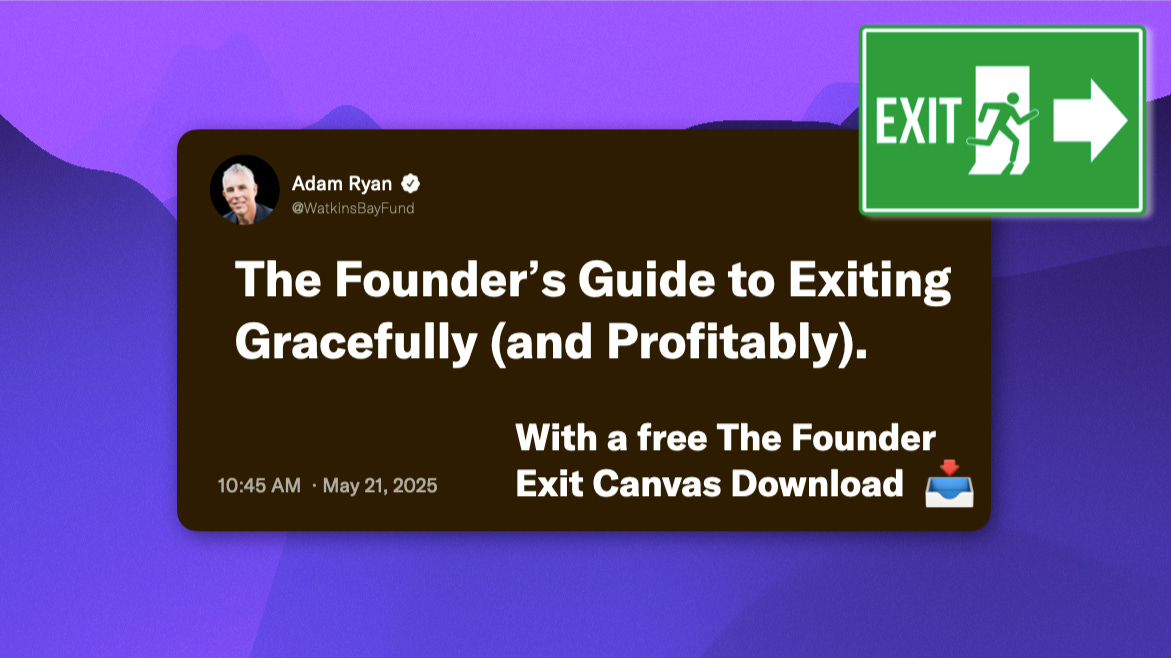The Founder’s Guide to Exiting Gracefully (and Profitably)
Exiting your startup can feel like stepping off a rollercoaster mid-ride. It’s emotional, high-stakes, and personal. For many founders, it’s their first time simultaneously navigating profound legacy
How to leave your startup without leaving value on the table for you, your team, and your investors
Exiting your startup can feel like stepping off a rollercoaster mid-ride. It’s emotional, high-stakes, and personal. For many founders, it’s their first time simultaneously navigating profound legacy and big liquidity.
And if done right, it can be one of the most defining (and rewarding) moments of your founder journey.
But here’s the problem: most founders don’t plan for it.
They hustle for years, raise capital, scale fast, and burn hard, only to realise too late that they don’t have a clean exit strategy. The result? Burned bridges. Lost leverage. Forfeited upside. And regret.
Let’s change that.
Whether you’re eyeing an acquisition, considering a merger, or stepping back from the company you founded, here’s how to exit constructively and still negotiate a slice of the cake for yourself and your shareholders.
Top 5 Mistakes Founders Make During an Exit
1. Starting Too Late
The number one exit killer? Delay.
Most founders only consider exit options when they’re burnt out or the business has hit a plateau. That’s like trying to sell your house after the roof collapses. Strategic exits begin 12–18 months in advance when you still have leverage, growth momentum, and multiple options.
Start planning your exit when you see a credible path to scale. Not when you’re desperate to get out.
2. Failing to Align Stakeholders Early
Surprises are for birthday parties, not exits.
Things unravel fast when key stakeholders, co-founders, investors, and team leads are left out of early conversations. Deals fall apart, trust erodes, and legal risks spike.
Exits are not solo missions. They’re collective negotiations. Align early. Communicate clearly. Document everything.
3. Optimising for Ego, Not Outcomes
Some founders care more about being on TechCrunch than getting the right deal.
They want the “founder hero” ending, even if it sacrifices structure, people, and economics. But headlines fade while bank balances and reputations last.
You’re not excited to look good; you’re excited to do right for the business, your team, and yourself.
4. Ignoring Cultural Legacy
Great startups aren’t just financial assets. They’re cultures, missions, and philosophies.
A rushed or misaligned exit can destroy what made your company special. Founders often overlook this until their people leave or the mission gets diluted post-acquisition.
Protect the culture. Negotiate not just the deal but also the values you want preserved.
5. Not Structuring the ‘Earn Out’ Wisely
Earn-outs are where many founders lose out.
They sound good in theory: “Stay a few years, hit goals, unlock extra money,” but they can turn into golden handcuffs in practice. Without clarity on targets, decision rights, and support, you may spend three years building someone else’s dream on their terms, not yours.
If there’s an earn-out, structure it like your future depends on it. Because it does.
5 Constructive Tips for a Smart Founder Exit
1. Build an Exit-Ready Business
Start with hygiene:
Clean books
Documented operations and agreements
Clear IP ownership
A reliable, empowered leadership team
Precise customer segmentation and predictable revenue
Buyers aren’t just buying ideas. They’re buying stability.
The more replaceable you make yourself, the more valuable your business becomes.
2. Know What You Want
Do you want freedom? A legacy? A new startup runway?
Clarify your priorities before entering negotiations. These affect your valuation floor, earn-out tolerance, equity rollover decisions, and role post-exit.
Founders who don’t know what they want usually get less than they deserve.
3. Pre-Negotiate the Cake
Your equity is hard-earned. Don’t assume people will protect your slice.
Spell out your retention package, advisory equity, transition timeline, brand usage rights, etc. Be especially vigilant if your company is acquired by a larger organisation, where you’ll be “just one of many.”
You don’t get what’s fair. You get what you negotiate.
4. Leave the House Better Than You Found It
Whether you’re excited to rest, reinvest, or reboot, do it with intention.
Train the incoming CEO. Write a founder letter to your team. Help onboard your acquirer. Set the tone. People will remember how you left, not just what you built.
Exits are done well to create reputational capital for life.
5. Stay Values-Driven
Your legacy is not your valuation. It’s how you treat people on your way up and down.Be transparent, generous, advocate for your team and investors, and stick to your principles.
Startups are temporary. Your reputation isn’t.
The Founder Exit Canvas
To make this actionable, here’s a simple canvas to navigate your exit. If you would like the Canvas, please subscribe to the Start-Up Growth Hacking Newsletter and leave a comment below, and I will DM you the link.
A smart exit is never an accident. It’s the result of values, clarity, and long-game thinking.
So start now. Think ahead. Surround yourself with wise counsel. And remember:
You didn’t build this just to let it unravel at the end. Exit with the same intention you used to create.
If you’re a founder thinking about your next move, I’d love to hear your story or help you craft the right exit. Leave a comment or DM me.
If you would like the Founder Exit Canvas, please subscribe to the Start-Up Grwoth Hacking Newsletter and leave a comment below, you can access it here.
#StartupExit #FoundersJourney #StartupLife #StartupTips #VentureCapital #Entrepreneurship #StartupLeadership #ExitStrategy #FounderWisdom #StartupGrowth #MVPtoExit #ScalingStartups #BuildToExit #StartupAdvice #StartupCulture








